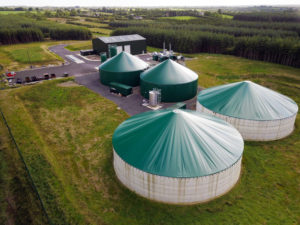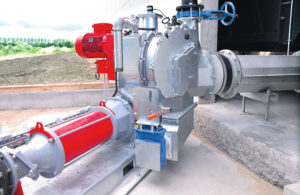Lower costs, fewer malfunctions: switching to liquid feeding
Biogas represents an important component in today’s mix of energy sources in many industrialised countries with huge future potential in Ireland. Ongoing developments in the renewable energy sector are placing new demands on the operators of biogas plants. For many operators, it is simply daily business – keeping their eyes and ears open and making the most of any opportunity to optimise their plants. If we look closely, there is still untapped potential for process optimisation in many biogas plants. Replacement investment for equipment in older plants is also a way to improve operations and even gas yield. This entails using efficient biogas technology to maximise the yield in relation to costs and making necessary adjustments to ensure compliance. After all, time is money, and biogas plant operators all too often find themselves having to fix problems rather than focusing on producing biogas.
More gas through bacteria-friendly solids feeding
One such way for optimising the digestion line is considering a modern liquid feeding system for efficient solids dosing. The experience of many plant operators and the EU-AGRO-BIOGAS research project in conjunction with Vogelsang, underline the benefits of modern wet feeding. The results from this research show a higher specific and absolute gas yield with liquid solids dosing compared with dry solids dosing. Feeding the solids in a well-mixed form and treating them optimally prior to the fermenter feed, makes them easily accessible for bacteria and prevents floating and settling layers. As a result, the solids are concentrated, which removes the need for energy-intensive mixing. This saves on energy and costs in the solids dosing process and in the fermenter circulation. Additionally, the input materials are used more effectively, which increases the specific gas yield.
A versatile digester feeder like Vogelsang’s PreMix clears the way for using alternative and lower-cost substrates, such as grass silage, agricultural residues and food waste. This gives operators greater flexibility in the feeding of biomass, and the potential to adapt their biogas plant to different input materials. The PreMix digester feeder not only handles a wide variety of biomass, but it also combines separation, mashing, preparation and pumping in one compact unit to allow for a homogeneous organic suspension to be fed into the digester(s).
Modern liquid feeding systems in action
Cranford Farming Company, located in Northamptonshire, England operates an agricultural feedstock based biogas

plant. The plant generates electrical power using maize silage, whole crop silage and grass silage as its solid feedstocks. Recently, they retrofitted a Vogelsang liquid feeding system which includes a supply pump and macerator downstream the solid matter feeder. The solid and liquid feedstocks are mixed together to a required ratio as a result of fitting both the feed pump and solid matter feeder drives with a variable speed drive. The resulting mixture passes through the macerator before being fed back into a low-level digester tank. This reduces the particle size of solids thereby increasing gas yield rates in the digester. Additionally, the integrated separator allows any heavy foreign bodies to drop out. The complete system is controlled by a PLC controller with an easy-to-use touch keypad interface for the operator.
With the new feeding system, solids are fed into the digester as a well-homogenised suspension. Sir John Robinson, owner of Cranford Farming Company, says, “I cannot fault the system. Its introduction has ensured a totally homogenised feed is made to the digester tank. This ensures good gas yield and makes the mixing in the digester much more efficient. Since the introduction we have experienced very few problems and any teething problems have been very quickly resolved.”
The 1 MW BioCore biogas plant located in Roscommon County, Ireland generates heat and energy from mostly wastewater sludge as well as grease from grease traps. They use a pasteurising process to ensure the end product is clean and meets Class A biosolids. With sewage sludge and local waste streams coming into the plant, there is variable consistency of feedstock being fed into the digesters. Therefore, they needed a feeding system that could handle a wide range of input materials and the ability to process difficult substrates safely and efficiently. BioCore decided to install the robust PreMix solid matter feeder to reliably handle the variable consistency of feedstock and also efficiently treat the sludge. The 4-in-1 system separates out foreign matter, mixes the substrates with the liquid suspension, cuts coarse and fibrous particles and pumps the homogenous suspension to the digester.

BioCore needed the biosolids to achieve Class A designation for pasteurisation, thus, a rigorous pre-treatment of the sludge and reduction of particle size within the medium was required. The Vogelsang RotaCut macerator was implemented as a stand-alone unit for the pasteurisation and optimally reduces the particle size to meet compliance requirements. Overall, the operations are running smooth and the plant is successfully producing energy from sewage sludge.
“We chose Vogelsang because it is a trusted name and we could rely on their technology. The PreMix reliably and consistently shreds and mixes the feedstock and the RotaCut accurately macerates the pasteurised material to achieve Class A quality,” says James Russell, Director at BioCore Plant.
Liquid feeding systems: Flexible plant expansions in future
Additional digestion space is the tried-and-tested standard method for growing a biogas plant. If liquid feeding is installed on the plant, the solids dosing for the new digester can be achieved with minimal cost. It is simply fed with the existing solids dosing via a new pipe.
Vogelsang consultants and experts work together with their customers to come up with individual concepts for modifying and expanding their biogas plants to ensure more efficient gas production. They offer a comprehensive range of products for the optimisation of biogas plants, whether for improving utilisation of the substrate, reducing energy consumption or simply ensuring trouble-free operation. Mark Hughes, Managing Director of Vogelsang Ireland says, “We aim to partner with biogas owners, operators and developers to determine the individual situation at each plant and identify the potential for improvements especially in optimising the digestion line. Investments for replacing technology are also due in many plants. We want to lay the right foundations for modernisation, to increase the economic yield of the plant.”

By starting at the beginning and employing efficient digester feeding, you can contribute to a more productive and profitable operation of your biogas system. Incorporating input materials in a well-mashed form will allow for optimal fermentation and in turn, increase the gas yield and reduce your energy requirements for mixing, stirring and pumping. In this respect digester feeding has a key function and taking a closer look at it will pay off.
